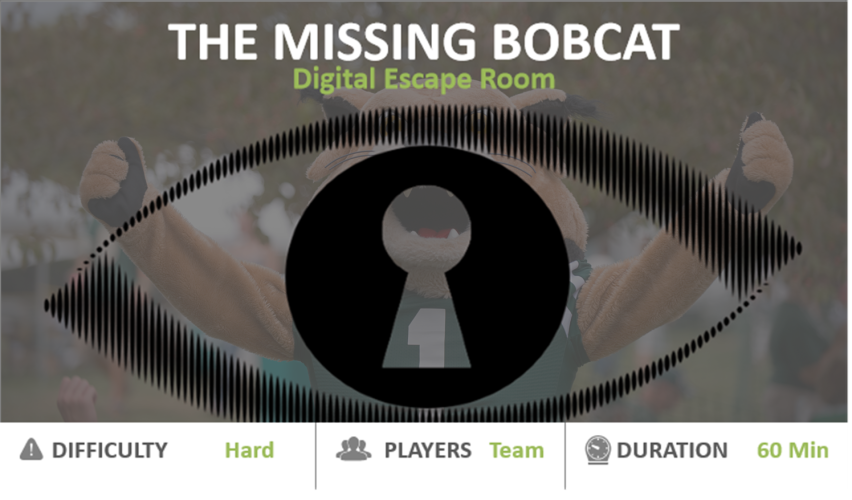
Students search for ‘missing Bobcat’ in virtual team-building experience

Last seen on College Green, Rufus the Bobcat goes missing prior to a rivalry game weekend versus Miami University. It is up to students to rescue Rufus from his kidnapper, Swoop the Redhawk, in time for the big game. In a series of tricks, riddles and puzzles, students travel across the Ohio University Athens campus in a virtual escape room simulation.
An escape room is a popular adventure game in which teams of players collaborate to find clues and unlock the room to leave before time runs out. Escape rooms, in demand since 2012, have been a way for family, friends or parties to work together and increase interpersonal communication.
But during the pandemic, adapting to the online world is part of the new norm. That prompted educators in the Ohio University College of Business to use innovative thinking to create a virtual escape room game—focused on the famous OHIO mascot—for students.
As Tammy Reynolds planned the virtual curriculum for her Select Leader Development Program class in the Robert D. Walter Center for Strategic Leadership, she sought a way for students to collaborate and use team-building skills.
That’s where Amy Toth came into play.
Toth, assistant director of program operations and planning for the College of Business, has a master’s degree in instructional design. She works on virtual escape rooms as learning exercises to help participants complete puzzles, find clues and work together. When paired with particular courses, the game helps reinforce curriculum information.
The Walter Center for Leadership Development hosts certificate programs for groups of Select Leaders and Emerging Leaders. In a typical semester, the center would put on team-building exercises for students to collaborate and get to know each other. However, with online instruction, an interactive event could not take place in-person.
Toth decided to collaborate with Reynolds and utilize her online design skills to create a virtual escape room for leadership students to take part in.
Reynolds wanted her students to have a fun team-building experience not tied to any particular lesson, that also allowed participants to chat and compete while playing.
“These are times that we have to be super creative when teaching remotely,” said Reynolds.
Toth then came up with the idea to simulate aspects of the Ohio University Athens campus into the escape room. The game included locations such as the Ridges and Baker Center, and ended in Copeland Hall. The premise of the game was to rescue Rufus the Bobcat mascot.
The game is called The Missing Bobcat Digital Escape Room. It can be accessed here: The Missing Bobcat Digital Escape Room.
Ross Ferraro, a junior studying management information systems and business analytics, has assisted Toth test other virtual escape rooms. Ferraro is a member of the Select Leaders, so this time around he was able to participate with the rest of his class.
After Toth developed the game and performed a series of beta testing, the game was ready for students to play.
“The game was about figuring out interactive riddles and puzzles, and we were clicking on various objects to see if they had any meaning to them or putting together a virtual jigsaw puzzle. It was very interactive. Not only did we collaborate with the people on our team and interact with the escape room itself, we were competing against some of the other teams to see who would complete it first,” Ferraro said.
Students had to work together and solve each puzzle to advance to the next level. The game encourages different strengths and skillsets that allow students to collaborate. Students also utilized Microsoft Teams to chat while playing. It took about 45 minutes to one hour to complete.
“The virtual escape room allowed the junior members of the Select Leaders program to work as a team in an engaging and animated way. It’s difficult to create virtual team-building experiences and as a close-knit group; we’ve struggled with not having our normal in-person interaction,” said Delaney Allen, a junior in the Select Leaders program. “The members who attended the event were excited to spend time with one another and do an activity that was both fun yet challenging.”
Exercises like Toth’s virtual escape room allow for connection during a time that students are not actively interacting in person. Toth’s creativity gave students in the program a positive and collaborative experience.
“We have to be concerned not just about teaching content, but the wellbeing of our students and community. And doing activities like this address collaboration and fun. We need to do more things that address the needs of so many of us who are social beings,” said Reynolds.
Reynolds plans to introduce the game to each of her incoming sophomore classes of Select Leaders.
